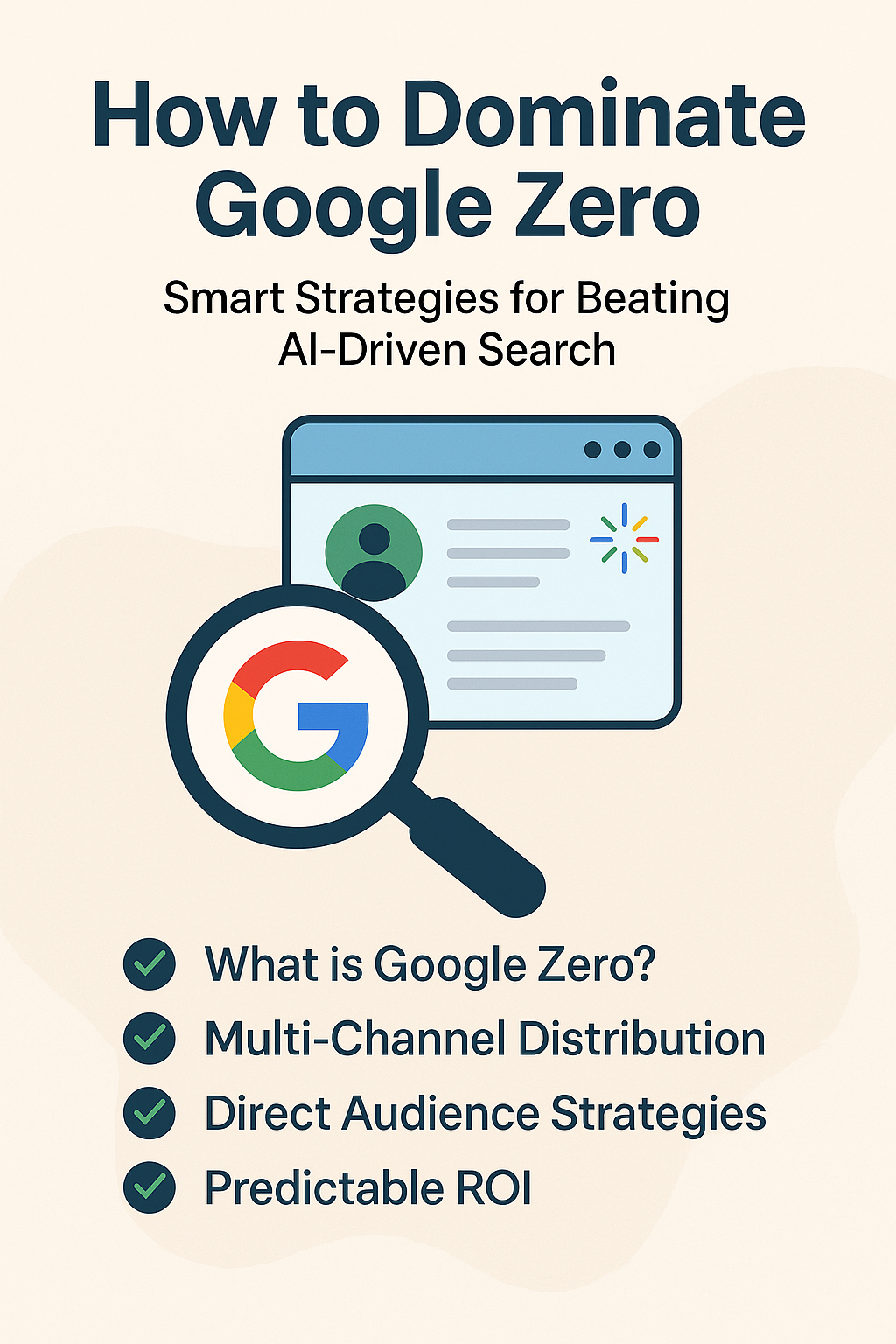Summary of the Article
- Google’s ever-changing search experience is reducing organic click-through rates by up to 50%, making traditional SEO less and less effective as a standalone strategy
- Multi-channel authority strategies spread your content across various platforms, creating multiple touchpoints with your audience while simultaneously strengthening your SEO
- Businesses that are leveraging media placements, video platforms, podcasts, social media, and direct distribution are seeing a higher ROI than those who are solely focused on Google rankings
- LeafWorldMedia’s content distribution approach helps businesses build authority across 300+ platforms, future-proofing your digital presence against algorithm changes
- Companies that are implementing multi-channel authority strategies report increased brand recognition, more diverse lead generation sources, and greater resilience to search algorithm updates
The landscape of digital marketing has fundamentally shifted. While you’ve been optimizing titles and building backlinks, Google has been quietly transforming into something that barely resembles the search engine we built our strategies around. Today’s smart businesses aren’t just adapting—they’re completely changing their approach.
There was a time when landing on the first page of Google’s search results was the holy grail of online visibility. These days, that might get you a spot beneath a host of ads, a featured snippet that answers a user’s query without them having to click on your site, and a shopping carousel that takes up most of the screen. The hard truth is that traditional SEO is on its way out, and LeafWorldMedia’s multi-channel authority approach is the next step businesses need to take to stay in the game.
We’re not saying to forget about SEO altogether—we’re saying that relying solely on Google has become more and more of a gamble. The businesses that are succeeding today are those that are building a presence across multiple channels at the same time, creating a digital footprint that is everywhere, and that generates traffic, leads, and sales no matter what changes are made to the algorithm.
Google’s Changing Environment: The Reasons Why SEO Alone Doesn’t Make the Grade Anymore
Do you recall when Google was simply ten blue links on a page? Those times have passed. Today’s search results pages are intricate environments where organic listings battle with an ever-growing assortment of SERP features. Featured snippets, knowledge panels, People Also Ask boxes, and image carousels now rule the space that organic listings used to.
This change is not by chance, but a calculated move. Google is shifting from being a search engine that directs users to other sites to a platform that keeps users within its own environment. The more queries Google can answer directly in the search results, the less users need to click through to your website.
This is a critical issue for businesses. The SEO strategies that were effective five years ago, or even a year ago, are quickly becoming less effective as Google prioritizes keeping users on its platform instead of directing them to yours.

The Real Problem: How Changes in Algorithms Are Killing Website Traffic
The numbers paint a grim picture. Research indicates that more than 50% of Google searches now end without a click to any website. Consider this—more than half of all searches don’t generate traffic to any site. This trend, commonly referred to as “zero-click searches,” signifies a huge change in how users engage with search results.
This isn’t just a problem for small businesses or specific industries. Big publishers and well-known brands are seeing huge drops in traffic after recent Google updates. Websites that used to depend almost entirely on organic search traffic are seeing their visitor numbers drop, even though their rankings have stayed the same or even gotten better.
The writing is on the wall: high rankings no longer ensure visibility or traffic. As Google improves its ability to answer questions directly in search results, the importance of traditional SEO continues to decrease.
Google Zero and Featured Snippets: The Click-Free Experience
Google Zero—the idea that Google can provide answers without the need for clicks—may be the biggest threat to traditional SEO. If users can find what they need right in the search results, they have less reason to visit your site, even if you’ve spent years optimizing for those exact keywords.
Featured snippets are a perfect example of this problem. Once upon a time, landing a featured snippet was seen as a major SEO victory. However, data is increasingly showing that these high-profile positions often lead to fewer clicks, not more. Google pulls the most valuable information from your content and displays it right in the search results, fulfilling the user’s query without them ever having to visit your site.
For businesses that are heavily invested in content marketing and SEO, this creates a painful dilemma: the better you answer users’ questions, the more likely Google is to display that answer directly in search results, which could potentially reduce your traffic instead of increasing it.
The 30-50% Decline in Organic Click-Through Rates
The statistics are clear. According to industry research, organic click-through rates (CTR) have fallen between 30-50% in many sectors over the last five years. Even if you rank #1 for certain keywords, you may only be getting a fraction of the clicks you would have gotten for the same ranking position in the past. This shift highlights the importance of diversifying your strategy, such as exploring buyer journey mapping to better understand and engage your audience.
The decrease isn’t consistent across all search categories. Informational searches—those looking for answers to questions—have the most significant declines in CTR as Google increasingly provides these answers directly. Transactional searches still generate more clicks, but even these are being affected as Google improves its shopping features and paid advertising options.
In the past, the SEO model was based on the assumption that a higher ranking would result in more traffic, and therefore more business. However, this is no longer always the case, and businesses are now having to reconsider their entire digital visibility strategy.
Why Being #1 Isn’t Enough Anymore
Even if you manage to secure the much sought after #1 spot, your content is still competing with a crowded search engine results page (SERP). Each year, the first organic result is pushed further down the page, now appearing below ads, featured snippets, and often several SERP features such as image carousels or “People Also Ask” boxes. This visual demotion means that even the top-ranked content is seen and clicked on less than ever before.
There’s no denying the data. A decade ago, the click-through rate for the top organic position was around 30%. Today, it’s often less than 20%, and some studies show even lower rates. So even if you manage to achieve that coveted ranking, you’ll get significantly less traffic than you would have just a few years ago.
Intelligent companies are acknowledging this new fact: traditional SEO success measurements such as rankings no longer directly relate to business results. This understanding is driving the critical move toward multi-channel authority tactics.
The Power of Multi-Channel Authority in Modern Digital Marketing
Although the ever-changing Google landscape can be difficult to navigate, it also opens up new avenues for businesses that are ready to evolve. Multi-channel authority is not merely a response to the constraints of SEO. It is a more comprehensive strategy that establishes numerous points of contact with your audience throughout the digital world.
Instead of the old school SEO that prioritizes Google’s organic rankings, a multi-channel authority strategy spreads your brand’s presence over a variety of platforms. This strategy ensures your brand is seen wherever your audience hangs out online, not only when they’re actively searching. It changes your online presence from a one-channel dependency to a presence that’s everywhere.
There are more perks than just improved visibility. Companies that have adopted multi-channel authority strategies have noted a wider variety of lead sources, better brand recognition, and perhaps the most significant, a higher resistance to algorithm modifications. When your company’s success isn’t reliant on the algorithms of a single platform, you gain strategic adaptability and decreased vulnerability.
Understanding Multi-Channel Authority
Multi-channel authority is about making your brand a well-known expert on many digital platforms at the same time. Instead of only focusing on ranking for certain keywords, you’re creating a broad digital presence that includes news websites, video platforms, podcasts, social media, and direct distribution channels.
This method makes use of content atomization, which involves breaking down main messages into formats that are best suited for each platform. One piece of cornerstone content can be turned into a news release, video segments, podcast episodes, social posts, and email content, ensuring maximum visibility from a single content investment.
The aim isn’t just to have a presence on multiple platforms, but to become a trusted expert on each one. By having a consistent brand presence across a variety of channels, you’re sending a strong signal of authority that goes beyond the constraints of any single platform. To understand how to achieve this, explore the concept of Omnicast, which focuses on multi-channel marketing strategies.
Why It’s Not Like Your Usual SEO Tactics
Old school SEO works on a give-and-take basis: you write content that’s optimized for certain keywords, with the aim of drawing in users who are actively searching for those words. It’s a passive approach, waiting for users to start the discovery process by searching. Multi-channel authority, on the other hand, actively presents your content to audiences on platforms they’re already using.
While SEO is primarily concerned with Google’s algorithm and ranking factors, multi-channel authority spreads the risk across several platforms. This method recognises that different audience segments prefer different methods of discovering content. Some depend on search, others on social media, others on podcasts or video content.
Crucially, while old-school SEO sees backlinks as the main measure of authority, multi-channel authority actually builds brand recognition and reputation. When users see your brand on multiple trusted platforms, you establish real authority that goes beyond algorithmic signals.

5 Platforms Smart Businesses Are Using in Addition to Google
Top digital marketers aren’t leaving Google behind—they’re adding to it with a strategic presence on platforms that offer a variety of benefits. Each of these channels offers unique opportunities to connect with audiences in ways that search alone can’t compete with.
1. Media and News Site Features
Being featured on reputable media and news sites offers instant credibility that organic search rankings can’t match. Features on these sites position your brand as relevant and worth talking about, creating third-party validation that resonates with audiences. These features usually generate high-quality referral traffic while simultaneously building powerful backlinks that strengthen your SEO foundation.
Press releases and media outreach are often dismissed by businesses as old-fashioned, but they can be incredibly powerful. Modern distribution networks can put your news on hundreds of sites at once, creating a visibility spike that you couldn’t achieve with organic search alone. Services like LeafWorldMedia’s Amplified Media Placements use these networks to turn a single press release into widespread digital visibility.
Each media placement has a cumulative effect. It not only increases direct visibility, but also enhances your brand’s newsworthiness for future placements. Over time, a consistent media presence builds a strong signal of authority that goes much further than what can be achieved through search rankings alone.
2. Video Platforms (YouTube, TikTok)
Video content has become incredibly popular, and platforms like YouTube are now the second-largest search engine in the world. The visual medium lets you communicate complex information in easy-to-understand formats, create personal relationships with audiences, and grab attention in ways that text content just can’t. In addition to YouTube, platforms like TikTok provide unparalleled organic reach potential, with content often going viral without paid promotion. For more insights, check out this article on videos and infographics.
3. Podcasts and Audio Content
More and more people are tuning into podcasts each year. In fact, over 60% of adults in the US are now podcast listeners. Podcasts are a great way to engage with your audience, as the average listener will listen to over 80% of each episode. This level of engagement is unheard of with written content. For those looking to expand their reach, consider exploring Omnicast strategies to maximize your podcast’s impact.
Podcasts provide two advantages for businesses: you can start your own program to establish a loyal audience, or you can be a guest on existing podcasts to attract new listeners. Guest appearances are especially effective for building authority because they place you next to recognized experts in your field. Consider exploring Omnicast for insights on leveraging podcasts for your business.
Audio content can reach people in ways other formats can’t – when they’re commuting, working out, or doing household chores and can’t look at a screen. This gives you more opportunities to connect with your audience throughout the day.
4. Building Authority Through Social Media
Even though the algorithms are constantly changing, social platforms are still potent channels for establishing topical authority and directly engaging with audiences. Unlike search, which necessitates users to actively look for information, social media enables you to proactively put content in users’ feeds based on their interests and behaviors. Each platform provides unique benefits—LinkedIn for B2B authority, Instagram for visual storytelling, Twitter for thought leadership, and emerging platforms like TikTok for grabbing attention with short-form video.
5. Direct Distribution and Email Marketing
When it comes to reaching your audience, email is the most direct and controlled channel. Owning an email list gives you algorithm-proof access to people who’ve already shown interest in your brand, unlike visibility that depends on the platform. Email marketing usually outperforms most other digital channels in terms of direct conversion value, with average ROI figures of $36-$42 for every dollar spent.
Smart email marketing is more than just sending out sales pitches—it means providing real value through informative content, industry knowledge, and special resources. This method changes your email list from a simple sales channel into a strong tool for building authority.
News Sites: They provide credibility from a third-party, have SEO benefits, and have a broad reach
Video Platforms: They provide visual engagement, are the second-largest search engine, and attract younger demographics
Podcasts: They have deep engagement, allow for passive consumption, and provide thought leadership
Social Media: They allow for community building, have viral potential, and provide targeted distribution
Email Marketing: They have an owned audience, the highest ROI, and a direct relationship
The best multi-channel authority strategies don’t see these platforms as separate entities. Rather, they create interconnected ecosystems where content is shared between channels, with each platform boosting and enhancing the others. A podcast episode turns into social media snippets, which lead to email subscriptions, which promote media placements—creating a beneficial cycle of visibility and engagement.
The Power of Multi-Channel Distribution for SEO
Multi-channel authority strategies are not the antithesis of SEO. Rather, they bolster it. By spreading content across a variety of platforms, you create a network of signals that improve your search presence while simultaneously lessening your reliance on it. This is a symbiotic relationship that many marketers overlook, viewing channels as rivals instead of complementary tools.
The truth about algorithms is this: Google and other search engines include brand recognition signals in their ranking algorithms. When users see your brand on different platforms, they’re more likely to click on your search results, which increases your click-through rates and indirectly improves your rankings. This positive feedback loop generates compounding returns that pure SEO strategies can’t compete with. For more insights on improving your search visibility, learn how to dominate Google Zero.
The rise of AI-driven search is hastening this shift. Both Google’s SGE and standalone AI assistants like ChatGPT place a great deal of emphasis on identifying authoritative sources. Content that shows up on a variety of reputable platforms is more likely to be mentioned and recommended by these systems, giving multi-channel authority strategies yet another edge.
The Power of Backlinks
By placing your content on different media platforms and distributing it widely, you are naturally generating high-quality backlinks from a variety of authoritative domains. These links not only drive traffic directly from referrals, but they also create strong SEO signals that increase your visibility organically. Unlike manual link building, which prioritizes quantity over quality, distributing your content across multiple channels creates natural, editorial links that carry a lot of weight in search algorithms. For a deeper understanding of how this works, explore our guide on measuring the ROI of multi-platform content distribution.
As Google continues to improve its algorithm to identify and lower the value of fake link patterns, the diversity of backlinks becomes increasingly crucial. Natural links from a variety of sources spanning different industries and platforms create a backlink profile that seems organic and reliable to search algorithms.
Several businesses have noticed that their SEO performance increases after they’ve put multi-channel authority strategies into action, even though they’ve spent less time on traditional optimization tactics. This unexpected result shows that building real authority is more powerful than technical SEO tactics.
Brand Awareness Signals
As users see your brand on various platforms, they become familiar with it and this influences their search behavior. They’re more likely to directly search for your brand, click on your results when they appear, and spend more time interacting with your content. These user behavior signals are fed back into search algorithms, creating a positive feedback loop that strengthens your overall search presence.
The mental process at play here is the mere exposure effect, where people tend to favor things they come across often. By being present on multiple platforms, you’re not only improving your chances of visibility; you’re actively fostering familiarity that leads to preference.
AI’s Fondness for Widely Spread Content
As search becomes more and more reliant on AI to produce results, the benefits of distributing content across multiple channels become even clearer. AI systems are programmed to identify and suggest sources that show a wide range of authority across the digital world. Content that is found on several respected platforms sends a clear message that it is reliable and useful.
Google’s Search Generative Experience and independent AI assistants like ChatGPT both prioritize information from recognized authorities when generating responses. By establishing your brand across diverse platforms, you position yourself to be cited and recommended by these AI systems—a critical advantage as they become increasingly central to information discovery.

Real-World Success: Businesses Thriving With Multi-Channel Strategies
The proof of multi-channel authority’s effectiveness is in the results businesses are achieving. Companies implementing comprehensive distribution strategies report not just higher visibility but more diverse lead sources, improved conversion rates, and greater resilience to algorithm changes. When one channel experiences disruption, others continue performing, creating business stability that single-channel dependency cannot match.
Companies in the financial sector are realizing that being featured on news outlets, podcasts, and video platforms creates a sense of reliability and knowledge that brings in clients more effectively than search alone. Healthcare providers have found that being present across multiple channels builds trust with patients before their first appointment, which improves both acquisition and retention. E-commerce brands have found that being everywhere creates confidence in making a purchase that goes beyond price competition, allowing for higher margins and customer loyalty.
These companies aren’t discarding SEO. Instead, they’re embedding it within a wider approach that opens up numerous avenues for consumers to find and select their brands. This diversification results in business resilience, shielding against the instability of any one platform.
3 Steps to Transition From SEO to Multi-Channel Authority
Shifting from a focus on SEO to a multi-channel authority strategy doesn’t mean you have to throw out everything you’ve done so far or start over. It’s about expanding your digital presence strategically, using the content and expertise you’ve already built up. Here’s a simple three-step plan that any business can follow.
Step 1: Evaluate Your Current Online Presence
Start by outlining your current online presence across all platforms. Where can you already be found? Where are you completely missing? Which channels are driving real business results versus those that are just taking up resources? This audit should include not just where you are posting content but where your audience is actually engaging with it. Many businesses find they are putting too much into low impact channels while ignoring high potential platforms where their audience is actively looking for information.
Step 2: Pinpoint Your Most Profitable Channels
Not all platforms are created equal. Depending on your business model, audience demographics, and content capabilities, some channels will bring in significantly more revenue than others. B2B companies often see their highest returns from LinkedIn, industry publications, and podcast appearances. Consumer brands might find Instagram, YouTube, and media placements in lifestyle publications more profitable.
Instead of spreading yourself too thin, it’s more effective to choose a few platforms and focus on maintaining a strong, consistent presence. You’ll see better results from five platforms where you’re always active and engaged than from ten platforms where your presence is inconsistent and unfocused.
When making these decisions, take into account both the demographics of the platform and the preferences for the format of the content. If your expertise is best expressed through long explanations, podcasts may produce better results than visual platforms. If your products need to be demonstrated, video platforms may take precedence over text-based channels.
Step 3: Establish Your Content Dissemination Strategy
The main hurdle in multi-channel authority isn’t generating ample content—it’s effectively disseminating content across platforms while preserving quality and uniformity. Successful businesses employ systematic methods that convert fundamental content into platform-specific resources. This could involve converting a comprehensive guide into a sequence of videos, social posts, podcast episodes, and media pitches, each tailored for its specific platform while preserving consistent messaging. Services like LeafWorldMedia’s OmniCast distribution system can automate a large part of this process, taking a single piece of content and converting it into resources disseminated across hundreds of platforms at the same time.
Tomorrow’s Winners Will Be Everywhere
As the digital marketing landscape evolves, the divide between single-channel and multi-channel brands will only grow. Brands that rely solely on traditional SEO will face an uphill battle as organic visibility continues to dwindle. But brands that adopt a comprehensive distribution strategy will build self-reinforcing authority that’s immune to algorithm changes and platform shifts.
Being seen in the digital world isn’t about being the king of one platform anymore—it’s about creating a network where your brand is consistent across the platforms your audience trusts and uses. This omnipresence doesn’t just make you more visible, it also builds trust, preference, and ultimately, better business results. If you’re ready to future-proof your digital marketing strategy, multi-channel authority isn’t just a choice—it’s the obvious way forward.
Common Questions
When businesses start to think about moving from traditional SEO to a multi-channel authority strategy, they often have a lot of questions. It’s important to have a good understanding of these issues when deciding what kind of digital marketing strategy to use. Here are some of the most common questions we get, along with some practical answers based on our experience.
These questions embody the inherent conflict between traditional methods and developing tactics. Although change always brings with it a level of uncertainty, the decreasing effectiveness of single-channel methods means that multi-channel authority is not just advantageous, but increasingly essential for long-term digital success.
It’s important to note that shifting to multi-channel authority doesn’t mean giving up on your current SEO efforts. Instead, it’s about using them as part of a more comprehensive strategy that gives you multiple ways to increase your visibility and attract customers.
Does traditional SEO still have a place in business?
Yes, it does. Multi-channel authority strategies are meant to work in conjunction with SEO, not replace it. Traditional search optimization still holds value, but its effectiveness as a solo strategy has decreased significantly. By spreading your content across multiple platforms, you’re actually boosting your SEO through increased brand recognition, varied backlink profiles, and better user engagement signals. The aim isn’t to abandon SEO, but to lessen your reliance on it as your main visibility channel.
Consider SEO as one key player in a symphony, not the whole ensemble. It’s a vital part, but the real power comes from all the parts working together. The most successful businesses keep investing in SEO while also strategically branching out into other channels that lessen the risk of algorithm changes.
What is the price tag for a multi-channel authority strategy?
The costs to implement a multi-channel authority strategy can vary greatly. If you are managing the distribution yourself across a few main platforms, you might only need to invest your time and pay minimal platform fees. If you are using a professional distribution service like LeafWorldMedia, you are looking at a monthly cost of $1,500-$5,000. This price will depend on how often you want to distribute content, how far you want your content to reach, and if you need help creating content. It is important to remember that you are not just evaluating the costs, but also the cost of doing nothing. If you continue to rely on organic visibility, which is decreasing, while your competitors are increasing their digital presence, you could be losing out.
How soon will I see results from adopting a multi-channel strategy?
Initial visibility gains usually occur within 30-60 days as content starts appearing on multiple platforms at the same time. However, the cumulative authority advantages accumulate over 3-6 months as your brand becomes known across the digital landscape. Unlike algorithmic SEO where rankings can fluctuate overnight, multi-channel authority provides lasting visibility that keeps getting stronger over time.
It usually takes about six months to see the most dramatic results, as your content on various platforms begins to interact and create a network effect that increases your visibility beyond what each individual channel could achieve. Businesses that have consistently used multi-channel strategies for 12 months or more report not only increased visibility, but also significant changes in how customers find and view their brands.
Should I be on all platforms or just a few?
Choosing strategically is better than trying to be everywhere. The most successful businesses focus on 5-7 main channels where they maintain a consistent, high-quality presence, supplemented by wider distribution to secondary platforms. The specific platforms should match your audience demographics, business model, and content creation capabilities. Quality and consistency across fewer platforms will yield better results than sporadic presence across many. For more insights, consider measuring the ROI of multi-platform content distribution.
How can I determine if my multi-channel authority strategy is working?
Success can’t be measured by one channel alone. Instead, you need to look at the bigger picture. Key signs of a successful strategy include a diversified traffic source, an increase in brand search volume, improved conversion rates across all channels, and less impact from algorithm updates. The usual channel-specific metrics are still important, but they should be considered as part of the overall business performance.
The most reliable measure of success is often the balance of traffic from search and non-search sources. As this balance becomes more equal, your business becomes more resistant to search volatility and captures audience segments that may not use search as their primary method of discovery.
As customers engage with your brand across various platforms before deciding to make a purchase, attribution modeling becomes more and more crucial. The most accurate depiction of how your business results are driven by your multi-channel presence is provided by sophisticated attribution systems that track cross-channel customer journeys.
Keep in mind that conventional SEO metrics such as rankings are becoming less relevant as direct search traffic makes up a smaller portion of your overall visibility. Instead, concentrate on business results—leads, sales, retention, and revenue growth—as the ultimate indicators of the success of your strategy.
Our digital world is changing at a rapid pace. AI is changing the way we search, and our attention is being pulled in many different directions. This is creating new challenges for businesses trying to get noticed. By embracing a multi-channel authority strategy, your business can thrive no matter how the individual platforms change. LeafWorldMedia has the expertise and distribution systems to help you build a resilient digital presence. And you don’t have to worry about the operational complexity of managing multiple platforms independently.







Leave a Reply